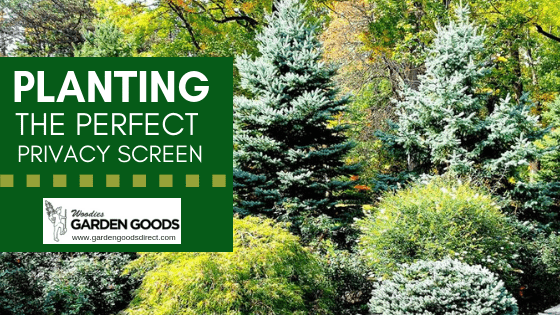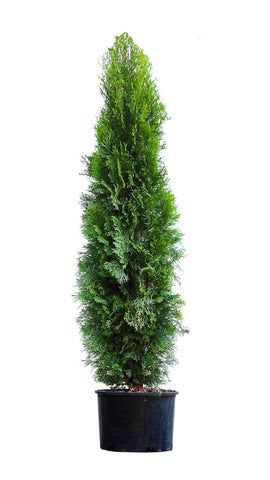
Planting the Perfect Privacy Screen
When you walk out the back door of your home, what is the first thing you see? Is it your neighbor's broken-down shed, or maybe it’s the children playing in the common area of your development? Whatever it is, wouldn’t you rather walk out the door into your own private sanctuary surrounded by shades of green in a noise-free environment?
Privacy screens are more important today than they have ever been. We all need some peace in our lives, and evergreen privacy screening plants offer that.

A Purpose Beyond Privacy
Privacy screens offer more than just privacy. Before we dive into the best plants to create a privacy screen, let’s first discuss the many reasons why you may be searching for privacy trees in the first place, beyond just marking property lines and creating privacy that is.
Enhance Curb Appeal
The number one reason to plant privacy trees, outside fo instilling privacy around your property, is for the enhanced curb appeal and added value it brings to your space. Fast-growing evergreens remain lush and beautiful throughout the season and bring so much beauty to any outdoor space!
Create A Sound Barrier
In addition to the natural beauty they offer to a landscape, evergreen trees are also great at offering sound reduction! If you live near a busy road, for example, a thick row of evergreen plants can be the perfect solution to creating a sound barrier against the hustle and bustle of heavy traffic.
Additionally, if your neighbors entertain frequently or are making noise into the wee hours of the morning, evergreen trees can be perfect for blocking those sound waves from carrying into your property and disturbing your peace.
Block Wind
Planting large privacy trees around your property also offers wind blocks which can help to keep your home warmer in the winter and reduce energy bills. Wind can also be a big cause to damage around your property, and these large evergreen trees can serve as a wall of protection against these damages!
Privacy Trees vs. Fences
You may say that a fence can serve a similar purpose to privacy trees, and in some cases, you would be correct. However, there are so many reasons to opt for a living wall of privacy over a fence! Below are just a few of the many reasons why we believe Privacy Trees are superior to fencing in the landscape.
- The overall cost of a screen planting is usually a fraction of the cost of building a fence.
- Privacy Trees Live upwards of 100 years serving as a long term solution to your privacy needs
- You can create a much taller screen or wind and noise buffer with evergreen trees than you can with a fence.
- Overall yearly maintenance costs of a fence can be astronomical compared to a “living fence”
- After a few years, most people tire of the look of a fence and start to plant trees and shrubs to cover the fence
- Most HOAs have regulations regarding fence styles and types, which can be difficult to work within.
- Many municipalities require a costly permit and property survey before a fence can be installed.
 Which types of plants can I use for a privacy hedge?
Which types of plants can I use for a privacy hedge?
The most visually appealing privacy screens are typically made up of various plants. You can choose from a myriad of colors, textures, and heights.
Typically, larger trees like the Thuja Green Giant or Emerald Green Arborvitaes make up the backdrop of your privacy screen. In addition to these large, hardy, evergreen trees that thrive in a range of environments, we would recommend the following trees for use in your privacy hedge.
Arborvitae

There are uncounted numbers of arborvitaes available in the market today. Arborvitae Degroot's Spire and Emerald Green are perfect for smaller properties where space is an issue. These can be planted as close together as 4 feet and will grow to a height of 14 feet.
Arborvitae Green Giant is best suited for larger properties and is deer-proof, which is important in some areas where deer tend to graze on landscapes. Green giants are fast growers, up to 5 feet per year, and can reach heights of up to 50 to 70 feet.
Thuja Nigra is a North American native plant and known for its hardiness. Great choice for medium landscapes as it can reach heights of up to 20 feet. Thuja Green Giant Arborvitae Trees grow up to 60 feet tall very quickly (about 4 feet a year), but you can still arrange them in a privacy screen for when you need your privacy in much bigger spaces.
Cypress Trees
Leyland Cypress have long been planted as privacy trees and still have a place in the landscape today. They are fast-growing, three to five feet per year, and are very tolerant of most soil conditions, including wet soils where few other plants can grow.
Holly Trees
For a different look, consider adding hollies to the screen. Nellie Stevens holly, with its dark green leaves and red berries, not only adds beauty year round but also provides habitat and protection for songbirds in the winter.
Hollies are relatively fast-growing and can reach heights of up to 20 feet. Ilex Opaca, or American Holly, is a beautiful evergreen tree that is native to the eastern United States. American Holly is more tolerant of shady areas than most others so consider planting this in your privacy screen.
Pine Trees
White Pines are a great choice for those looking for a more open and airy privacy screen. White Pines are long-lived and are a great choice for windbreaks as they are very sturdy. They are very hardy and thrive in colder, more northern zones.
Spruce Trees
The Baby Blue Spruce is a slow-growing version of the native Colorado Blue Spruce. Excellent as a small, colorful evergreen tree that never requires pruning. Perfect for smaller gardens or confined spaces. Baby blue brings a wonderful soft blue to any landscape hedge. It’s slower growing than most of the other privacy trees but well worth the wait.

Smaller plants for use in screens
If you are looking to instill a privacy hedge in your landscape but do not have the space to home a massive 50-foot tree, there are some great privacy shrub options for you to choose from!
Photinia
The Red-Tip Photinia is first on the list of popular shrubs used for privacy purposes. The oval leaves of photinia plants start out bright red but turn into a dark reddish-green after a couple of weeks to a month. During the spring, the photinia also has small white flowers that produce red fruits, which often last into the winter. These hardy evergreen shrubs can reach heights of up to 12 to 15 feet and offer wonderful color throughout the year.

Laurel
Next on the list of elite shrubs to use for privacy in the landscape is the Cherry Laurel. The Skip Cherry Laurel is a handsome shrub or medium hedge plant that tolerates filtered sunlight or dappled shade.
Skip Cherry Laurels produce glossy, medium-green foliage with a refined look on a dense, vase-shaped form. Stalks of fragrant white flowers appear in spring. These gorgeous shrubs can reach heights of up to 12 feet and respond well to pruning. Botanically referenced as 'Schip Laurel, 'the Skip Cherry can produce a very formal look when used as a medium hedge.
Boxwood
Last but certainly not least on the list of shrubs to use for hedging is the classic and well-loved boxwood shrub.
The Dee Runk Boxwood is a fan favorite among our boxwood varieties. Reaching heights around 9 feet tall, the Dee Runk is known for its columnar habit and dark green foliage that keeps its color throughout the year. With an easy care regimen and a tolerance to a wide range of soil mediums, the Dee Runk is a great choice for smaller privacy hedges!
Privacy Tree Accent Plants
In front of the screen, you may also choose to incorporate medium or small shrubs to add color to the screen. The color of the smaller shrubs really pops against the darker backdrop. Imagine a beautifully mixed row of arborvitaes, cypress, junipers, pines, boxwoods, and hollies creating a backdrop for colorful shrubs such as azaleas, photinias, euonymus, or our favorite spring or fall blooming camellias!

What is the best layout for a privacy screen?
There are no set rules when it comes to planting your privacy screen. There are, however, some guidelines set by those who've planted before us and learned from their planting mistakes and successes!
The number one concept to keep in mind regarding the planting of your trees outside of growing conditions is spacing. These evergreen trees can grow to be exceptionally large specimens, so before planting, you must account for their mature height and width before mapping out your planting and then space the plants accordingly.
Outside of proper spacing, the layout for your privacy hedge is open to your imagination and own personal preferences! Privacy hedges can be planted in a straight line for a formal look.
On the other hand, evergreen trees can also be planted in a staggered double row for a less conventional look! This not only creates privacy faster but also creates a dense screen that has the best sound buffering capability. The final method, and my personal favorite, is to plant the trees in small groups, which creates a more natural look.
One of the most basic principles of landscape design is that nature doesn’t create in straight lines. Therefore, to mimic nature most effectively, we can plant in small groups or informal waves instead of one straight line. This method is ideal if you have a larger space and want something different.
Whichever design you choose, remember there is no right or wrong way to do it. It’s your screen; plant it in a way that most reflects your personal style.
Shop Privacy Plants Online Today
Remember, it’s a proven fact that the best relationships with neighbors begin with a privacy screen! We're here to simplify the process by shipping these hardy, evergreen privacy plants straight to your doorstep! Skip the heavy lifting, long lines, and crowds of your local garden center this season, and shop all of your landscaping needs online today at gardengoodsdirect.com!
Until next time, See you in the garden (or not if you have a privacy screen),
- Woodie
